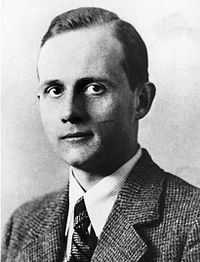Ernst vom Rath


Ernst Eduard vom Rath (3 June 1909 – 9 November 1938) was a German diplomat, remembered for his assassination in Paris in 1938 by a Jewish young man, Herschel Grynszpan, which touched off Kristallnacht, The Night of Broken Glass.
Early life and career
Vom Rath was born in Frankfurt am Main to an aristocratic family, the son of a high-ranking public official, Gustav vom Rath. He attended a school in Breslau, and then studied law at Bonn, Munich and Königsberg, until 1932, when he joined the Nazi Party and became a career diplomat. In April 1933 he became a member of the SA, the party's paramilitary. [1] In 1935, after a posting in Bucharest, he was posted to the German embassy in Paris.
Assassination
In November 1938, aged 29, vom Rath was shot and mortally wounded by a 17-year-old Polish Jewish youth, Herschel Grynszpan, who had fled from Germany to France. Why Grynszpan chose vom Rath is not known with certainty, although it is known that he was upset over news that his family was being deported from Germany back to Poland. Most accounts of the shooting state that Grynszpan did not ask for Rath by name but only asked to speak to a member of the diplomatic staff.[2] Vom Rath died of his wounds after two days. Kristallnacht was launched immediately after his death.
Aftermath
After the killing there were claims that vom Rath was a homosexual, and that Grynszpan was intending to use this claim in his defence at the trial by implying that Rath had seduced him. Joseph Goebbels had been intending to turn the trial into Nazi propaganda about Jewish conspiracy, but the homosexuality accusations threatened to humiliate the Nazis. Goebbels wrote that "Grynszpan has invented the insolent argument that he had a homosexual relationship with... vom Rath. That is, of course, a shameless lie; however it is thought out very cleverly and would, if brought out in the course of a public trial, certainly become the main argument of enemy propaganda."[3]
Whether or not Rath was homosexual is not known; the French writer Andre Gide, himself a homosexual, testified in his personal diaries that vom Rath was well known in the Parisian homosexual community. There were rumours that occasionally he was called "Madame Ambassador" and "Notre Dame de Paris"... His brother, Gustav, was convicted of homosexual offences and there were allegations that vom Rath was treated for rectal gonorrhoea at the Berlin Institute of Radiology.[1][4] As a result of the potential embarrassment the trial was indefinitely postponed.[5] Grynszpan was extradited to Germany after the defeat of France in 1940 and is believed to have died in a German prison or concentration camp sometime after 1942, but was not officially declared deceased until 1960.
References
| Wikimedia Commons has media related to Ernst vom Rath. |
- ↑ 1.0 1.1 Schwab, Gerald, The Day the Holocaust Began: The Odyssey of Herschel Grynszpan, Praeger, New York, 1990, pp. 14, 142, 186
- ↑ Strauss, Herbert A. Jewish immigrants of the Nazi period in the USA Volume 4, 1992: "Even the assertion that persists stubbornly to this day that vom Rath was only an accidental victim, that Grynszpan actually wanted to kill the highest-ranking representative of the German Reich in France, the ambassador, has been called into question since it emerged. There exists a series of Nazi forgeries in preparation of a show trial against Grynszpan following his abduction to Germany in July 1940. In this way, the theory that the Jews had instigated the Second World War was to be backed up, and the ongoing deportations publicly justified. In fact, there is some evidence that vom Rath and Grynszpan had already known one another."
- ↑ Gerald Schwab, The Day the Holocaust Began: The Odyssey of Herschel Grynszpan, Praeger, New York, 1990. p. 142
- ↑ Tamagne, Florence (2006), A history of homosexuality in Europe: Volume 1 & 2: Berlin/London/Paris - 1919-39, Algora Publishing, p. 373, note 531, ISBN 0-87586-357-4
- ↑ Sidney Smeets. De wanhoopsdaad: hoe een zeventienjarige jongen de Kristallnacht ontketende, Balans, Amsterdam, 2013.
|